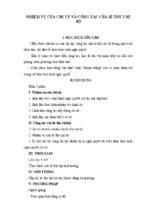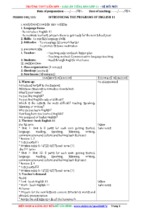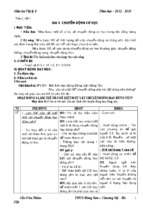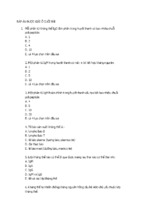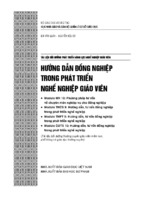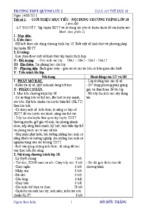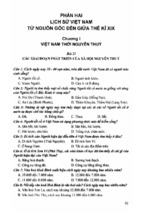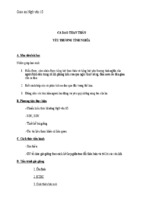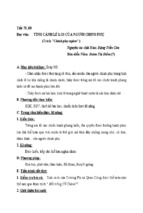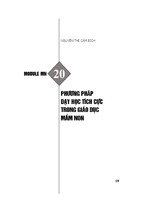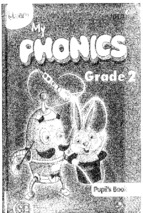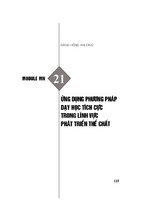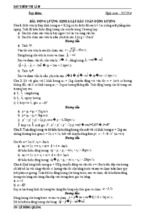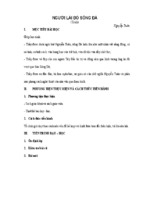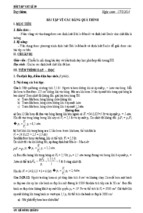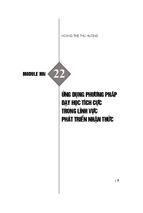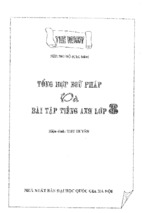Date of planning:
13/08/2011
Date of
teaching15/08/2011
Period 1: Revision & 15 minute test
I. Objectives:
- To give ss further practice: Past simple tense, simple future, comparative
and superlative of long adjs, adverbs of manner, exclamations
- Skill:
+ Target skill : speaking
+ Other skills : Reading, writing, listening
- Main teaching points: To help ss improve the structures above
- By the end of the lesson ss will be able to improve their knowledge and
do exercises fluently
II. Teaching aids:
- Teacher: Teacher’s book, lesson plan
- SS : Textbook, school things
III. Procedures:
1.Warm up:(2)
past simple tense
Elicit forms from ss
?
simple future
2. New lesson: (24)
Stage
2.1 Practice 1
Past simple tense
Teacher’s & students’
activities
Teacher elicits form
from ss
2.2 Practice 2
Simple future
Teacher elicits form
from ss
Content of the lesson
(+) S + Ved / irregular verbs
(-) S + didn’t + bare V
(?) Did + S + bare V?
Yes, S + did
No, S + didn’t
(+) S + will /shall +Bare V
(-) S + will /shall not +Bare V
(?) Will /Shall+ S + bare V?
Yes, will / shall
No, S + will/shall + not
S1+ be + more adj + than + S2
S + be+ the most +adj
S + V (tense) + ( very) + adv of
manner
What + (a /an) + adj + N/s / unc!
2.3 Practice 3
Teacher elicits form
comparative and
from ss
superlative of long
adjs
2.4 Practice 4
Adverbs of manner Teacher elicits form
2.5 Exclamations
from ss
3. Test 15 minutes:
Question I: Give the correct form of the verbs in brackets.(5ps)
1. She enjoys ( learn) English.
2. I am interested in ( listen) to music.
3. Don’t worry! We ( wait) for you.
4. Minh (not go) to school yesterday because he ( catch) a cold .
5. How often you ( play ) soccer?
6. When I (be) a child, I often (go) fishing
7. At the moment Thoa (sit) in Dr. Khoa’s surgery.He (check) her teeth.
Question II: Rewrite the following sentences in such a away that it means
exactly the same as the sentence printed before it (5ps)
1. What is your daughter’s age, Mrs Mai? How........................................?
2. You shouldn’t eat too much meat. You’d ................................................
3. I get to work in half an hour. It takes .......................................................
4. How much is this dictionary? How much does.......................................?
5. Do you have a more exspensive computer than this? Is this..............?
4. Keys:
1
QI:
1. learning 2. listening 3. will wait 4. didn’t go/caught
5. do you play
6. was/went
7. is sitting/is checking
QII: 1. How old is your daughter, Mrs Hoa?
2. You’d better not eat too much meat.
3. It takes me half an hour to get to work.
4.How much does this dictionary cost?
5. Is this the most expensive computer you have?
5. Homework: (2)
- Learn structures by heart
- Check the test again
- Prepare unit one: Getting started + Listen and repeat
****************************************************************
Date of planning:
Period 2: UNIT 1: MY FRIENDS
16/08/2011
Lesson 1: Getting started + Listen & Read
I. Aims and Objectives:
- Helping ss to understand the content of the dialogue, structures :S + be
(not) + adj + enough ( for obj) + to V, and review simple present tense, simple
past tense
- Vocabulary: To in troduce to ss some vocabulary: a next – door
neighbor, enough(adj), (to) look like, (to) seem,(to) smile
- Skill:
+ Target skill : Speaking
+ Other skills: Listening, reading, writing.
- Main teaching points: S + be (not) + adj enough ( for obj) + to V
- By the end of the lesson Ss will be able to describe people & using
ENOUGH to talk about one’s ability.
II. Preperation:
- Teacher: posters, teacher’s book, lesson plan, radio, tape script
- Ss : textbook, schoolthings
III. Teaching process:
1. Check up: (2’)
- Ask two ss to write form past simple tense & simple present tense
2. Lead in:(2’)
Have ss look at the pictures and describe some groups of their friends’favorite
activities.
Answer the questions:
+ What are these students doing?
+ What time of the day do you think it is?
+ Do you like soccer/reading books?
+ What about Lan and Hoa? Let’s come to our new lesson today.
3. New lesson:(37’)
Stage
Teacher and stidents’activities
Content
2
a.Pre
teach
vocabular
y:
(5’)
T elicits words from ss
T models, ask ss to read inchorus,
individually and give meaning
Check understanding: Ro + R
- enough(adj) explanation
:®ñ
- (to) seem ( translation): dêng nh
- A next door neighbor
( explanation): ngêi hµng
b. Set the T. shows pictures(Hoa, Lan, photo of
scene:(3’) Hoa and Nien) and elicit qs & answer xãm
from ss . Who is this? It’s Hoa
- to look like (situation):
Who is this? It’s Lan. What are they
tr«ng gièng nh
talking about? They are talking about
- (to) smile ( miming ): mØm
Hoa’s photograph
cêi
c.Present
Ask ss to listen to the tape carefully
the text:
(3 times) to get the detail of the text
Hoa’s photograph
(5’)
and find out the pronunciation.
d.Do
Pair work- students ask & answer
comprehe questions (p. 11)
nsi-on
- T monitors take notes and give the
task:(10’) correct answers.
(page11)
T. asks questions to draw student’s
Lan
Hoa
e. Present attention to structures and vocabulary.
new target “Pick out the words and expressions
She wasn’t old enough to be
item.(14’) describing Nien“
in Hoa’s class.
What is this sentence into VNamese? S + be( not) + adj +
What comes after “enough”? to V
enough + to-infinitive
Concept
What comes before” enough”? adj
Complete the sentences
check:
Elicits form from ss
1. Nga/not/old /enough/
Elicits use from ss: To express
go to class.
someone has enough ability to do
2. They/clever/
something
enough /answer that
-Ask some ss to practice in front of
question.
the class.
3. Mai /tall/ enough
Practice
- T monitors takes notes & correct
/reach the bookshelf
4. She / not /strong /
enough/ carry this box
4. Summary:(2’)
- Repeat the use and form of ENOUGH to talk about one’s abilities.
5. Home work:(2’)
- Learn vocabulary and structure by heart, write full answer for the Qs
- Describe the people in their family photograph , using words and
expressions already learnt in Tieng Anh 6 + 7.
- Students bring their photos to class (preparing for speaking pratice in
lesson 2)
****************************************************************
*
Date of planning:
Period 03: Unit 1: MY FRIENDS
17/08/2011
Lesson 2: Speak
Date of teaching
3
19/08/2011
I. Aims and Objectives:
- Helping ss know how to describe one’s appearance & listen for specific
information.
- Vocabulary: To introduce to ss some vocabulary: curly, blond, fair,
straight, beard, moustache, bold = bald
- Skill
+ Target skills: Speaking, listening
+ Other skills: Listening, reading , writing.
- Main teaching points: Structure:
What + do/does + S + look like? S + be + Adj
to describe one’s appearance
- By the end of the lesson, Ss will be able to use adjs & structures to
describe one’s appearance and improve their speaking and listening skills.
II. Teaching aids:
- Teacher: Posters, teacher’s book, casset, tape script
- SS: Textbook, schoolthings
III. Procedures:
1. Check up:(3)
- 4 ss do execise 4 page 17
2. Lead in:(2’)
“In daily life, we always have to communicate with other people. Thus, it
is imprtant to know the adjs & structures to describe one’s appearance. Today we
will deal with this matter”
3. New lesson:(36’)
Stage
3.1Prespeaking
(7’)
Preteach
vocabul
ary
(5’)
Set the
sence(2’
)
Teacher’s & students’activities
T elicits words from ss
T models, ask ss to read inchorus,
individually and give meaning
Check understanding: Ro + R
T. shows pictures of some peopleasking some questions.
What are they? What are they
like/What do they look like?
Describe their hair and
appearance ;Using structures: S +
have/has + adj + hair
S + be + adj
4
Content of the lesson
- curly(adj), explanation:
xo¨n, qu¨n
- blond(adj), translation:
vµng ãng, vµng hoe
the beard, example: r©u
- the moustache, translation:
ria
- bold = bald (adj), picture :
hãi ®Çu
- fair (adj), antonym:
tr¾ng(da) vµng nh¹t (tãc)
T. asks students to complete the
network of adjectives.
T. tells Ss that they will learn more
adj to describe people.
T. calls some Ss (having the physical
features similar to those given in the
While
boxes) to the front of the class
–
T. asks Ss to look at 6 pictures in the
speaking text book and call on a student to use
(10’)
the adjs given in the boxes & the
verb HAVE to describe one person,
the others have to guess who he / she
is
- Go on until six people on the poster
are describeed.
PostT. shows 3 or 4 pictures of famous
speaking people. Some pairs of Ss practice the
( 4’)
dialogue with these pictures. OR: T.
asks Ss to show the photos they
brought to class (homework of lesson
1)- Ss practice describing people in
the photos.
T. calls one student to describe
another student in class; other Ss
guess who that person is.
-T monitors, takes notes and corrects
Hoa: This person is short &
thin. She has long blond
hair.
Lan : Is this Mary?
Hoa : Yes.
Build
Tall,
short,
fat,
slim,
thin,
muscu
lar,....
Hair
Long, short, straight,
curly, bold, black,
blond, brown, beard,
moustache, wavy, …
Example: This person is
very short and fat. She has
short hair. She is a famous
singer. Who is she?
=> She is My Linh
4. Summary:(2’)
- repeat the structure to describe a one’s appearance
5. Homework:(2’)
- Write about the people in the photo you brought to class (name, job,
body build, hair).
Example: This person’s name is _________. He is a (doctor). He is tall and
slim. He has curly short black hair.
- Prepare: Unit 1: part “read”
***************************************************************
Date of planning:
21/08/2011
Date of teaching
22/08/2011
Period 04: Unit 1: MY FRIENDS
Lesson 3: Listen
I. Aims and Objectives:
- Helping ss know how to describe one’s appearance & listen for specific
information.
- Vocabulary: To introduce to ss some vocabulary: curly, blond, fair,
straight, beard, moustache, bold = bald
- Skill
+ Target skills: Speaking, listening
5
+ Other skills: Listening, reading , writing.
- Main teaching points: Structure:
What + do/does + S + look like? S + be + Adj
to describe one’s appearance
- By the end of the lesson, Ss will be able to use adjs & structures to
describe one’s appearance and improve their speaking and listening skills.
II. Teaching aids:
- Teacher: Posters, teacher’s book, casset, tape script
- SS: Textbook, schoolthings
III. Procedures:
1. Check up:(3)
- 4 ss do execise 4 page 17
2. Lead in:(2’)
“In daily life, we always have to communicate with other people. Thus, it
is imprtant to know the adjs & structures to describe one’s appearance. Today we
will deal with this matter”
3. New lesson:(36’)
3.1
Whilelistening
(7’)
3.2 Postlistening
(4’)
T. reviews the expressions for
greetings- explaining when to use
them.
Ss read these expressions (p. 12)
Ss read the 4 conversations (pp. 1213) and try to guess and complete
four dialogues, using the given
expressions.
T. asks Ss to get ready to listen to the
tape and check if their
answers(words in the blanks) are
correct.
Ss listen to the tape (all 4
conversations).(twice)
Ss listen again with a pause after
each conversation.
Ask ss to work in pairs to compare
with their predictions
_ T gives the correct answer
Call on some ss to play the roles of
Nam- Hoa - Thu, Khai-Mrs Lien,
Mrs Vi, Ba, grandmother, Mr LAmMrs Linh, Mr Thanh and practice the
dialogues
Ss work in groups of 3 or 4 and
practice introducing to people.
T monitors takes notes and correct
their pronunciation and grammar
mistakes
Guessing:
1, how do you do
2, nice to meet you
3, come and meet
4, It’s pleasure to meet you
5,come and meet
6, nice to meet you
Key:
1, I’d like to meet you
2, nice to meet you
3, I’d like to meet you
4, It’s pleasure to meet you
5,come and meet
6, how do you do
4. Summary:(2’)
- repeat the structure to describe a one’s appearance
6
5. Homework:(2’)
- Write about the people in the photo you brought to class (name, job,
body build, hair).
Example: This person’s name is _________. He is a (doctor). He is tall and
slim. He has curly short black hair.
- Prepare: Unit 1: part “read”
Date of planning:
23/08/2011
Date of teaching
25/08/2011
I.Aims and Objectives:
Period 05: Unit 1: MY FRIENDS
Lesson 4: Read
- Helping ss know more about describing people by reading a text
- Vocabulary: sociable, character, generous, hard – working, reserved,
orphanage, outgoing, sense of humor.
- Skill
+ Target skill: Reading
+ Other skills: Listening, speaking, writing
- Main teaching points: Reading for specific information
- By the end of the lesson ,Ss will be able to understand the vocabulary,
the content of the text and know more about Ba’s friend
II. Teaching aids:
- Teacher: teacher’s book, lesson plan, poster
- Ss: textbook, schoolthings
III. Procedures:
1. Check up:(3’ Ask one ss to describe a famous person & the rest guess
2. Lead in:(2’) Today , you’re going to read a text about Ba’s friends. What
are their characters? Now we will deal with this matter.
3. New lesson:( 36’)
Stage
3.1Prereading:
( 11’)
Pre teach
vocabulary:
Set
thesence:
T/F
stateme
Teachers & students activities
Techniques: situation, antonym,
antonym
translation,example explanation
antonym explanation, example
T elicits words from ss
T models, ask ss to read inchorus,
individually and give meaning
Check understanding: Ro + R
T. asks question about Ss’ friends:
do you have many friends? What
are they like? What do they like
doing in their free time?
Ask ss to look at the statements
which are about Ba and his friends
7
Content of the lesson
I. Vocabulary:
- sociable(adj):chan hoµ,dÔ gÇn
- generous(adj),: hµo phãng
- hard - working(adj): ch¨m chØ
- reserved(adj):kÝn ®¸o
- an orhanage: tr¹i trÎ må c«i
- outgoing(adj): dÔ tÝnh ,cëi më
- the sense of humor:cã khiÕu hµi hưíc.
-a character: tÝnh nÕt, tÝnh c¸ch
II. Reading:
T/F predictions:
a. Ba only has three friends , Bao,
Song and Khai
b.Ba & his friends have the same
characters
-nts
predicti
-ns
and ask them to guess which
sentences are true or false
3.2
Ask ss to open the textbook ,
read the text silently and check
their predictions
T gives the correct answers
Ask ss to read the text and
complete the information about Ba
and his friends.
Ss work in group of four
- T monitors, takes notes and give
the correct answers
Whilereading:
(17’)
Gap fill
Multiple
choice:
Comprehens
-ion Qs
3.3Postreading:
( 8’)
Ask Ss to work in pairs to do the
exercises 1 (page 14).
- T monitors, takes notes and give
the correct answers
Ask ss to work in pairs, ask and
answer about the Qs in exercise 2
(p14).
- T monitors, takes notes and give
the correct answers
c. Bao-Song –Khai are quite
reserved in public
d. They all enjoy school and study
hard.
Answer keys: a.F b.F c. F d.T
* Read the text find suitabe adjs to
fill in the table
character
favorite
activities
Ba
Bao
Khai
Song
Answer:
character
Favorite
activities
Ba
-not as
-telling
outgoing/socia jokes
ble as Bao
-with a sense
of humor
Bao
-Sociable,
-doing
kind,
volunteer
generous,
work
hard-working
Khai - reserved in
-playing
public
soccer
Song -reserved in
-going
public
the local
library
Ask ss to work in groups of 4 or 5.
Each student describes one friend
in the group (character & favorite
activities).
Representatives of some groups
describe their group members.
Other Ss guess who they are.
- T monitors, takes notes and give
the correct answers
4. Summary:(2’) Repeat the content of the dialogue
5. Home work:(2’)
8
-Write some sentences about your close friend or one member in your family
(his/her character & favorite activities).
- Prepare Unit 1: Part write
********************************************************
Date of planning:25/08/2011
Date of teaching:27/08/2011
Period 06: Unit 1: MY FRIENDS
Lesson 5: Write
I.Aims and Objectives:
- Helping ss to write themselves and about other people.
- Developing writing skill.
- Vocabulary:
-adjectives (about human character and appearance)Review
- Skill
+ Target skill: Writing
+ Other skills: Reading , listening, speaking
- Main teaching points: Writing about oneself and about other people.
- By the end of the lesson,Ss will be able to write a paragraph to describe
about themselves and about other people.
II. Teaching aids:
-Teacher:
Word cards (adjs describing body build, hair, character), lesson plan, teacher’s
book.
- SS: textbook, schoolthings
III. Procedures:
1. Check up:(3’) - Have one ss to rewrite vocabulary.
- Ask one ss to retell the content of the text.
2. Lead in:(2’) You know how to describe people . Today we’ll learn how to
write a paragraph about yourself and about your friends in formal writing
3. New lesson:(36’)
Stage
3.1Pre –
writing:
(11)
Set the
sence:
Teacher’s & Students’ activities
Content of the lesson
- Have ps write adjs about characters I. Revision vocabulary:
of a person.
* Net work:
* Ask ss to read the information
Character
about Tam then answer some
questions.
II. writing:
1) Read the information about Tam.
- Have them work in pairs.
a) P1. What his name?
P2. His name is Le Van Tam.
b) P1.How old is he?
P2. He is fourteen.
9
- Call some pairs to practice in front
of the class.
3. 2
While
writing:
(17’)
3.3
Post
writing:
(8’)
- Ask ss if they understand the text
or not
* Ask ps to write a similar form for
their partners. Use the following
questions as prompts.
a) What is his/her name?
b) How old is he/she?
c) What does he/she look like?
d) What is he/she like?
e) Where does he/she live?
f) Who does he/she live with?
g) Who is/ are his/her friend(s)?
- Call some ss to ask and answer
these questions in front of the class.
* Have ss write a paragraph about
one of their partners using the form
they’ve made above.( groups of five)
- Ask the tutors to write on the
board.
- Ask other students to give their
remarks.
- T monitos, takes notes and give the
correct answers
c) P1. What does he look like?
P2. He is tall and thin. He has
short black hair.
d) P1. What is he like?
P2. He is sociable, humorous
and helpful.
e) P1. Where does he live?
P2. He lives at 26 Tran Hung Dao
street.
f) P1. Whom does he live with?
P2. He lives with his mother, father
and elder brother.
g) P1. Who is his friend?
P2. Ba and Bao
2) Fill in similar form for your partner.
Name: ...........
Age: .........
Appearance: ......................
Character:
......................
Address:
......................
Family:
......................
Friends:
......................
- Practice in pairs.
3) Now write a paragraph about your
partner.
+ Sample: This is my friend. His/her
name is .... and he/she is ..... years old/
He/she .......... at ...... in .......... with
his/her ................, his/her parents and
his/her ..... sister,... . He/she is .....
and ........... He/she has ...... black hair.
He/she is rather shy but friendly and
helpful. He/she has a lot of friends but
his/her close friends are... and....
4. Summary: (2’)
- Retell how to write a paragraph
5.Homework:(2’)
Have ss write a similar paragraph about one of their family members.
10
Prepare unit one: part language focus
***************************************************************
Date of planning:27/08/2011
Date of teaching:29/08/2011
Period 7: Unit 1:MY FRIENDS
Lesson 6 : Language focus
I.Aims and Objectives:
- To give ss further practice in :Simple tenses
Present simple to talk about general truths
Using structure: “(not) adj + enough + to infinitive” to talk about one’s
abilities
- Vocabulary:
Revision
- Skill
+ Target skill: speaking
+ Other skills: Reading , listening, writing
- Main teaching points: Simple tenses, (not) adj + enough + to infinitive
- By the end of the lesson ,Ss will be able to use simple tense to talk
about general truths & using the structure: (not) adj + enough to talk
about one’s abilities
II. Teaching aids:
Teacher:Textbook, poster
SS: textbook, schoolthings
III. Procedures:
1. Warm up: (2’)
Revision adjs: Elicit from ss
2. New lesson:(39’)
Stage
Teacher’ s &
ss’ activities
2.1
- Elicit form from ss
Practice
1(15’)
Smple
present
-Elicit use from ss
tense
- Elicit form from ss
Past
simple
tense
-Elicit use from ss
Ask ss to do EX 1,2
( p16)
- T monitors, takes notes
& give the correct
answers
The content of the lesson
I. Present simple and past simple
tenses:
Form: (+) S + Vs / Ves /Vies / bare V
(-) S + don’t / doesn’t + bare V
(?) Do / Does + S + bare V? Yes, S + do
/ does
No, S + don’t / doesn’t
It is used to express an action which is
always true.
Form: (+) S + Ved / irregular verbs
(-) S + didn’t + bare V
(?) Did + S + bare V? Yes, S + did
No, S + didn’t
It expresses an action which happened
& completed in the past.
1. Exercise 1 (page16)
Keys: a, 1- is living, 2- sent, 3- was, 4is.
b, 1- are, 2- came, 3- showed, 4introduced.
11
2. Exercise2 (page16).
Keys : 1.sets, 2. goes, 3.moves, 4.is, 5.
is, 6.is.
II. Exercise 3
Questions: Page 17
2.2
Have ss look at the
Practice 2 picture on page 17
(10’)
Work in pairs to ask and
answer the questions
- T monitors, takes notes
& give the correct
answers
2.3
- Elicit form from ss
III. (not) adjective + enough+ to Practice 3 -Elicit use from ss
infinitive
(14’)
Have ss work in pairs to S + be (not) + adj + enough + ( for obj)
complete the dialogue
+ to V
( Ex 4/p17)
It expresses someone has enough
abiltity to do sth
- Ask ss to make up 5
Keys: a. not big enough
sentences individually
b. not old enough
(using: enough)
- T monitors, takes notes c. strong enough
d. good enough
& give the correct
answers
3.Summary: (2’)
Repeat the use of present & past simple tense, the use of enough
4.Home work:(2’
Do exercies in the language focus again
Pepare Unit: Getting started + L & R
*************************************************************
Date of planning:30/08/2011
Date of teaching:03/ 09/2011
Unit 2: Making arrangements
Period 8: Lesson 1: Getting started, Listen and read.
I. Objectives:
- After the lesson, Ss will be able to use the telephone to make and confirm
arrangements.
II. Preparation:
- Textbook, cassette and tape.
III. Teaching procedure:
1. Organization:
- Date : ...............8A:...........
................8B:............
2. Oral test:
- Homework correction.
3. New lesson:
A. Warm- up: Getting started:
- Ask Ss to match each object (pictures on P.18) with its name.
- T hangs the picture and asks Ss to guess what objects they are .
- T presents some news words
a, an answering machine.
d, a telephone directory
b, a mobile phone
e, a public telephone.
12
c, a fax machine
f, an address book.
- T asks one Ss to match each object with its name .Others can make any
corection or addition .
- T corrects if necessary.
B. Presentation:
* Pre- reading:
- Give some questions for Ss to guess:
a. Who made the call?
b. Who introduced herself?
c. Who invited the other to the movie?
d. Who arranged a meeting place?
e. Who arranged the time?
f. Who agreed to the time?
- Give feedback.
* While- reading:
- Ask Ss to listen to the conversation.
- Get ss to read the conversation.
- Ask Ss to answer the given questions above.
1. Comprehension questions:
- Give Ss some more questions and ask Ss to work in pairs to answer them.
a. What is Hoa’s telephone number?
b. Which movie are they going to see? Where?
c. How is Hoa going to see the movie?
d. Where are they going to meet? What time?
- Get some pairs to ask and answer those questions.
* Post- reading:
- Ask Ss to play the roles of two Ss who are talkinhg on the phone making
arrangements.
- Ss can change the information if needed.
- Let Ss work in pairs.
- Call some pairs to practice.
4. Consolidation:
.- T asks to match each sentence below with its difinition .
a.an answering machine.
b.an address book
c.a public telephone
d.a fax machine
e.a telephone directory
f.a mobile phone
1.To send fax
2.to leave and take message
3.To find someone’s telephone numbers
4.To make a phone call in the street telehone box
5.To write addresses and phone numbers
6.To make a phone call anywhere you like .
5. Homework:
- Do ex 1 ( workbook)
- Practice the dialogue .
- Learn new words
-----------------------------------------------------------------------------Date of planning:04/09/2011
Date of teaching:06/09/2011
13
arrangements
Unit 2: Making
Period 9: Lesson 2: Speak
I. Objectives:
- After the lesson, Ss will be able to talk on the phone about intentions with
GOING TO.
II. Preparation:
- Textbook.
III. Teaching procedure:
1. Organization:
2. Oral test:
- Homework correction.
3. New lesson:
A. Warm- up: Chatting:
- Talk to Ss about using telephone.
Do you have telephone at home?
How often do you make a phone call?
What would you say when you pick up the phone to answer it?
What would you say if you are the caller?
B. Presentation:
* Pre- speaking :
- Ask Ss to do Ex 1 on P.20.
- Ss work in pairs.
- Call some Ss to give the answers.
- T corrects and gives the right ones:
b - f - j - a - i - c - e - k - g - h - d.
- Ask some quetions to check Ss’ understanding .
Are they talking on the phone? (Yes)
What do they intend to do?
(They intend to go to the pop concert.)
What time are they meeting? (They are meeting at 7.15)
Where?
(Inside the center)
- Form:
S + be + going to + infinitive.
- Use:
Express an intention
* While- speaking
- Word cue drill
- Model sentences :
+ Are you going to see a movie ?- Yes, I am?No, I an not.
a. see a movie
b. play sports
c. meet your friends
d. help your mother
e. do your homework
f. wath TV.
- Model two cues then ask Ss to repeat chorally then individually .
- Ask some Ss to practice asking and answering .
- Ask the whole class to work in pairs
*Post- speaking : Role play
- set thescene “ Ba and Bao are making arrangements to play chess ”
- Ask Ss to work in pair to complete the dialogue .
4. Consolidation:
- Revise the structure Going to.
5. Homework:
- Review the use of the structure.
14
- Do the Ex 2,3 in the workbook.
Date of planning:06/09/2011
Date of teaching:09/09/2011
arrangements
Unit 2: Making
Period 10: Lesson 3: Listen
I. Objectives:
- After the lesson, Ss will be able to talk on the phone about intentions with
GOING TO.
II. Preparation:
- Textbook.
III. Teaching procedure:
1. Organization:
2. Oral test:
- Homework correction.
3. New lesson:
A. Warm- up: Chatting:
- Talk to Ss about using telephone.
Do you have telephone at home?
How often do you make a phone call?
What would you say when you pick up the phone to answer it?
What would you say if you are the caller?
B. Presentation:
* Pre- listening:
- Ask Ss to look at the form of the telephone message pn P.21 and set the scene.
- Have Ss guess the message.
- Let Ss work in pairs.
- Give feedback.
* While- listening:
- Get Ss to listen to the tape twice and fill in the message.
- Ask Ss to compare with their guess.
- Call some Ss to give the answers.
- T plays the tape once again and pauses at each information for Ss to check.
- T gives answers:
kingston junior high school
Date: .............................
Time:...............
For: The principle.
Message: Mr Mary Nguyen wanted to see you at
9.45 in the morning.
Telephone number: 64683720942
* Post- Listening:
- Get Ss to repeat some sentences in the tapescript.
- Remind Ss the key points.
4. Consolidation:
- Revise the structure Going to.
5. Homework:
15
- Review the use of the structure.
- Do the Ex 2,3 in the workbook.
Date of planning:07/09/2011
Date of teaching:09/09/2011
Unit 2: Making arrangements
Period 11 : Lesson 5: Read.
I. Objectives:
- After the lesson, Ss will be able to know more about Alexander Graham Bell.
II. Preparation:
- Textbook.
III. Teaching procedure:
1. Organization:
- Date : ...............8A:...........
................8B:............
................8C:............
2. Oral test:
- Homework correction.
3. New lesson:
A. Warm- up: Brainstorming:
- Let Ss answer the questions by coming to the board and write:
To chat with friend
to communicate
What is the
telephone used for?
* Possible answers:
- to have a message.
- to call someone.
- to make arrangements
- to talk to a person who lives far away.
- to get information at the airport or railway station quickly.
B. Presentation:
* Pre- reading:
- Teach the vocabulary.
to emigrate: di c.
to transmit: truyÒn sãng.
to conduct: tiÕn hµnh
to demonstrate: minh ho¹
a device: dông cô
a deaf- mute: ngêi c©m ®iÕc
+ Checking:What and where.
- Get Ss to repeat aloud.
- Give T/ F statements prediction:
a, Alexander G.Bell was born in the USA.
b, He worked with deaf-mute patients in a hospital in Boston.
c, Thomas Watson was Bell’s assistant.
d, Bell and Watson introduced the telephone in 1877.
16
e, Bell experimented with ways of transmitting speech between deafmutes.
f, Bell demonstrated his invention at a lot of exhibitions.
* While- reading:
- ask Ss to read the text on p.21-22 and check their prediction.
- Have Ss correct the false sentences.
- Ask Ss to look at the book p.22.
- Get Ss to read the events of Bell’s life and put them in the correct order.
- Ask them to compare with their partners.
+ Alexander Graham Bell:
1. was born in Scotland.
2. went to live in Canada.
3. went to live in the USA.
4. worked with people who could neither speak nor hear.
5. worked with Thomas Watson.
6. successfully demonstrated his invention.
7. invented the telephone.
* Post- reading:
- Get Ss to write a paragraph about Bell’s life, using the information from the
text.
4.Consolidation :
- T revives Ss about the past simple tense.
S + V( in the past) + O
5. Homework:
- Ask Ss to write the paragraph into their notebook.
-------------------------------------------------------------------------Date of planning:09/09/2011
Date of teaching:12/09/2011
Unit 2: Making arrangements
Period 12: Lesson 5: Write.
I. Objectives:
- After the lesson, Ss will be able to write a telephone message.
II. Preparation:
- Textbook.
III. Teaching procedure:
1. Organization:
- Date : ...............8A:...........
................8B:............
................8C:............
2. Oral test:
- Homework correction.
3. New lesson:
A. Warm- up: Jumbled words:
1. mcuestor = customer.
3. ayddmi = midday.
2. essgmea = message.
4. nifurretu = furniture.
5. rvseice = service.
B. Presentation:
* Pre- writing:
- Talk to Ss about taking a telephone message.
- Have you ever taken a telephone message?
17
(Yes/ No)
- What should be mentioned in the message when you take a message?
( Date, time, who sent, to whom, content)
- Teach some new words:
a customer: kh¸ch hµng
a delivery: ph©n ph¸t/ vËn chuyÓn
stationery: hµng t¹p ho¸
to pick SB up: ®ãn ai
* Checking:What and where.
* While- writing:
- Ask Ss to read the message and fill in the gabs in the passage on P, 23.
- Let Ss work in pairs.
- Ask Ss to read the passage 2 to get information and write the message.
- Let Ss work individually, then compare with their partners.
* Answers:
Thanh Cong Delivery Service
Date:
June 16
Time:
After midday.
For:
Mrs. Van
Message: Mr. Nam called about his stationery
order. He wanted you to call him at 8634028.
Taken by: Mr. Toan
- Ask Ss to write another message.
- Set the scene: “Tom phoned Nancy, but she was out. Lisa, Nancy’s sister took
the message for Nancy. Help Lisa to write a message.”
- Ask Ss to read the dialogue between Lisa and Tom then write the message.
- Let Ss work in pairs.
* Post- writing:
- Give feedback:
* Answers:
Date: (.............)
Time: (............)
For: Nancy.
Message: Tom called about playing tennis this afternoon. He will
come over to pick you up at 1.30.
Taken by: Lisa.
4.Consolidation :
- T revives Ss the way of writing a message in English .
Date :..................................................
Time :......................................................
For :.........................................................
Message :.....................................................
Taken by :............................................................
5. Homework:
- Ask Ss to write the message on their notebook.
----------------------------------------------------------------
Date of planning:10/09/2011
Date of teaching:12/09/2011
18
.
Unit 2: Making arrangements
Period 13: Lesson 6: Language Focus.
I. Objectives:
- Further practice in the structure “be going to” and the adverbs of place.
II. Preparation:
- Textbook.
III. Teaching procedure:
1. Organization:
- Date : ...............8A:...........
................8B:............
................8C:............
2. Oral test:
- Homework correction.
3. New lesson:
A. Warm- up: Matching:
A
B
1. make
a. the time
2. arrange
b. an invitation
3. introduce
c. a call
4. accept
d. a letter
5. send
e. oneself
1:.........
2:..........
3:........
4:.........
5:..........
B. Presentation:
1. Language focus 1:
- Explain the task and ask Ss to practice this Ex in pairs.
- Call some Ss to write their answers on the board.
- Ask the rest to practice orally.
- Give the right answers:
a, They are going to go fishing.
b, Trang is going to read the new novel.
c, Van is going to do her homework in Math.
d, He is going to see the movie on TV tonight.
e, Hien is going to attend a birthday party.
- Ss copy the right answers.
2. Language focus :
- Set the scene and ask Ss to practice speaking with the given questionnaire.
What are you going to do on the weekend?
Are you going to....
You
Your partner
see a movie?
play sports?
meet your friends?
help your parents?
do your homework?
watch TV?
- Call some pairs to practice in front of the class.
- Give some remarks.
3. Language focus 3:
- Explain the way to practice.
- Ask Ss to revise some adverbs of place given in the textbook.
- Get Ss to practice in groups.
- Call some Ss to give the answers.
- Give feedback: a, upstairs.
d, outside
b, here
e, there
19
c, downstairs
f, inside
- Ask Ss to give some more examples with those advebs of place.
4. Consolidation:
- Remind Ss the structure “be going to” and the adverbs of place.
5. Homework:
- Review all key grammar points.
- Prepare the next lesson: Unit 3.
****************************************************************
Date of planning:12/09/2011
Date of teaching:14/09/2011
Unit 3: At home.
Period 14: Lesson 1:Getting started, Listen and read.
I. Objectives:
- After the lesson, Ss will be able to understand the dialogue and use model
verbs to talk about the housework.
II. Preparation:
- Textbook, cassette and tape.
III. Teaching procedure:
1. Organization:
- Date : ...............8A:...........
................8B:............
................8C:............
2. Oral test:
- Homework correction.
3. New lesson:
A. Warm- up/ Getting started: Kims, game:
- Show 6 pictures to Ss.
- Ask Ss to look at the pictures quickly in 30 seconds and try to remember the
verbs in the pictures as many as possible.
- Which team remembering more verbs is the winner.
* Answer: a, wash dishes
d, cook
b, make the bed
e, tidy up
c, sweep the floor
f, feed the chicken.
B. Presentation:
1. Pre- reading:
- Teach the new words:
a steamer: nåi hÇm
chore: viÖc vÆt trong nhµ
a cup board: ch¹n b¸t ®Üa
a sink: bån röa b¸t.
a sauce pan: xoong/ nåi nÊu canh.
* Checking:What and where.
2. While- reading:
- Play the tape twice for Ss to practice listening.
- Ask Ss to practice reading the dialogue in pairs.
- Call some pairs to read aloud.
- Present the use of the model verbs.
- Give form:
Has/ Have to + infinitive = must + bare infinitive.
- Ask Ss to list the things Nam has to do.
- cook the dinner
20
- Xem thêm -

